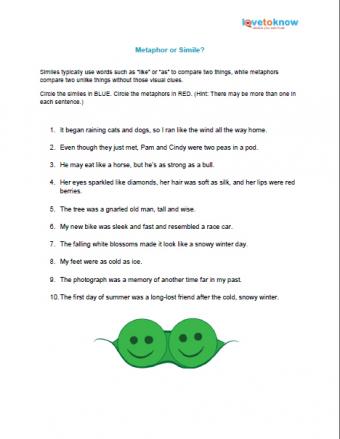
Figurative language is a way to say one thing while meaning something entirely different. It is often used in poetry and includes forms of speech such as apostrophe, alliteration, hyperbole, idiom, metaphor, onomatopoeia, personification, simile, and understatement. Teaching figurative language should begin with learning how and when each device is used in context.
Figurative Language Definitions
Print and reference the printable below which offers different forms of figurative language with their definitions and examples. (Note that in order to see the printable properly, you have to have the latest version of Adobe reader that you can download for free.) You may wish to display it in on a wall or bulletin board, or print a copy for your child to keep as a reference. The definition and example list can help you as you use various strategies to teach figurative language.

Metaphor or Simile Worksheet
Younger children may have a harder time with some of the many complicated types of figurative language, so you may wish to start with just explaining the two most common types: metaphors and similies. The worksheet provided below defines metaphor and simile and offers children an opportunitiy to work with these two pieces of speech. Print the worksheet and have your child determine whether each example uses a metaphor or a simile, or both.

Recognizing Figurative Language Worksheet
Recognizing figurative language in everyday conversations and in text takes some practice. For older students, begin with the Metaphor or Simile worksheet as an introduction, and then move onto the second worksheet, entitled Recognizing Figurative Language. Ask your child to fill in the blank with each type of literary device used in each sentence. A word box is included to help children remember all of the types of devices as well as how to spell them.

Poetry Reading and Identification
One of the most common places to find figurative language is within the lines of a poem. Poetry is known for its imagery and often utilizes figures of speech to reach that end. Reading poetry that uses specific literary devices and discussing each instance within the text can be an effective teaching strategy.
Try reading the following poems or songs that make use of various forms of figurative language to your child. As you read aloud, see if your child can find the literary device. For younger children, you may wish to let them know which device they should find, and possibly have them jump up or clap when they hear it. For older children, see if they can figure out which form of figurative language is found in each example.
- Alliteration: Shel Silverstein has many poems that feature the initial sound repetition of alliteration, such as Where the Sidewalk Ends and Sarah Cynthia Sylvia Stout.
- Hyperbole: The American folktale Babe the Blue Ox begins with hyperbole with a far-fetched description of the cold weather.
- Idiom: "Good fences make good neighbors" is an idiom used in Robert Frost's "Mending Wall."
- Metaphor: Summer Sun by Robert Louis Stephenson uses metaphors in describing the sun.
- Onomatopoeia: Baa Baa Black Sheep and Old MacDonald Had a Farm both feature animal sounds, but onomatopoeia can be found throughout poetry.
- Personification: Humpty Dumpty is a classic example of poetry which uses personification.
- Simile: Mary Had a Little Lamb states that "her fleece was white as snow," using simile to describe the animal's coat.
- Understatement: Imagining by Shel Silverstein makes use of this literary device. Older children may find Robert Frost's Fire and Ice worthy of discussion, as Frost uses understatement in the final line of the poem.
Recognition Activities
It is important for children to begin to recognize figurative language within everyday speech and within the context of a written work. The following teaching strategies offer ways to help your child recognize these literary devices.
Puzzle Match
Use the Definitions and Examples printable above to create a figurative language puzzle. This can be done with a simple puzzle with a base. On the backs of each puzzle piece, write a figure of speech. On the corresponding piece on the base, write an example of that type of figurative speech. Your child can now put together the puzzle by matching the word to a sentence which makes use of the language. This is an especially helpful teaching strategy for younger children.
Figurative Language Hullabaloo
The game known as Hullabaloo by Cranium invites kids to get active with a device that calls out hints and urges children to jump to "pads" which are spread in a room. You can make your own figurative language version of this game for just as much fun, learning, and recognition of figures of speech. On thick paper or construction paper, write the different types of figurative language. You may wish to cut them into fun shapes and laminate them so that they last for many uses. Spread the pieces of paper in an open area. Use the Definitions and Examples printable to call out either an example or a definition of a device and have your child jump, run, skip, or slither to the appropriate "pad."
I Spy
The children's game of I Spy is fun and challenging and can be played almost anywhere. You can adapt this game as a teaching strategy for parts of speech. Figurative language is everywhere. You might hear it on a commercial or in conversation. You might see it on a billboard or in a book. Challenge your child to find five examples of figurative language in a day or, if you have more than one child, see who can find the most examples within a certain time period. The unique twist of this game is that children can spot pictures that depict some of these devices. For instance, a sun wearing sunglasses is personification.
Make It a Game
Pick one literary device each day and try to integrate it into your conversations as a teaching strategy. If your child recognizes it, you can praise him or reward him with a sticker or five minutes of computer time. For instance, while making lunch, you might say, "It's certainly smelling savory. Soup's on!" Show your approval if your child recognizes the alliteration. You can take this game a step further by asking your child to return in kind. He might reply, "Soup sounds scrumptious!"
Turn It Into Art
Take a poem which utilizes a literary device, such as personification, and ask your child to draw two pictures, one which illustrates the literal and one which shows the figurative meaning of the same poem. This can be fun to do with simple phrases such as "He is such a pig" or "The dark night sky was filled with diamonds."
Strategies for Reinforcement and Further Learning
Once your child recognizes figurative language, it is time to weave it into his or her writing as a way of reinforcing this new skill. Working figurative language into writing can be a difficult concept at first, but consciously thinking about it will help figures of speech to become a regular resource in your child's writing toolbox.
Ideas to Consider
To help your kids gain a deeper knowledge, try these fun teaching strategies.
- Have your child take a common rhyme or popular poem and rewrite it, removing any instances of figurative language. You may end up with some silly poems, but your student will come away from this exercise understanding the importance of this literary device.
- Take a non-poetic piece of writing and ask your child to re-write it with the addition of figurative language. He may recreate directions to a recipe, an article in the newspaper, the Preamble to the Constitution, or anything else that lacks even the hint of a simile, metaphor, or hyperbole.
- Encourage your child to reach beyond overused similes and be creative. Why say "white as snow" when you can say "white as a newly-bleached shirt"?
- Another fun project may be taking an ordinary, everyday object, such as shampoo or salad dressing, and creating a print advertisement that makes use of figures of speech.
Additional Resources
There are a number of additional resources for figurative language activities and exercises, including:
- GameAquarium.org - This site features a wide variety of exercises and activities to help teach figurative language that are free to download. You can tell which ones have been the most popular with users because of the star-based rating system, as well as rate any that you decide to use for the benefit of others.
- SpellingCity.com - Here, you can choose from a list of printable worksheets and activities. The list features worksheet titles along with specific grade level information, making it easy to narrow your search to documents most likely to meet your child's needs. Anyone can download these worksheets at no cost; if you have a fee-based premium membership, you can actually make assignmetns directly to students through the website.
- WartGames.com - Visit this site for a variety of educational games about figurative language. Some are online games, while others offer printable instructions and/or activities. There are also a few PowerPoint presentations on this site. All resources are available at no cost.
Common Problems
In addition to teaching your child what metaphors are and how to use them, it's also important to help him avoid developing problematic usage patterns.
Overuse
As your child becomes more familiar with figures of speech, he will begin to utilize them in many different forms of writing. Now is the time to teach restraint. Overusing figurative language can overwhelm a reader, whereas a sprinkling of these literary devices adds depth and maturity to a piece of writing. Skilled writers know when to use the tools at hand and when to refrain.
Misuse
Additionally, teach your student about the misuse of words, such as with mixed metaphors. A mixed metaphor is a group of incongruous metaphors that often result in an absurd mental picture. An example of a mixed metaphor might be "Now that the ball is in your court, I can see the light at the end of the tunnel."
Clichés
Now may also be an appropriate time to teach about clichés, which are figures of speech that have lost their impact through overuse. Examples of clichés include "her cheeks were as red as roses," "he avoids homework like the plague," or "don't look a gift horse in the mouth." It's important to teach the meaning of these overused parts of speech so that kids can understand their meaning and begin to use more creative alternatives.
Now What?
Figurative language is a fun concept both to teach and to learn. Remember to use a variety of approaches and activities to reinforce your child's understanding of the topic. Even after the lesson is over, it's important to continue encouraging your child to use figurative language in his speech and writing. Like most new skills, your child's understanding of this invaluable tool will increase with repetition until he knows it like the back of his hand.







